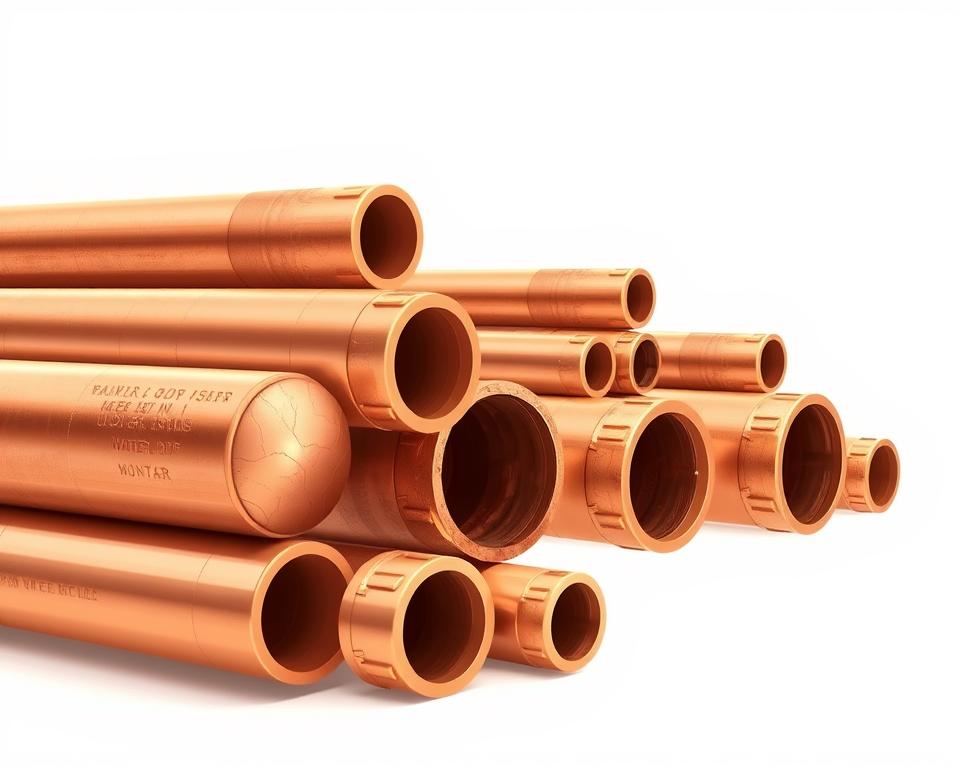Your Guide to Copper Water Line Sizing at Home
Did you realize that almost 30% of household plumbing problems are caused by pipes of the wrong size? Using the proper dimensions helps maintain ideal water pressure and system efficiency. Here’s a homeowner’s primer on the sizing essentials for residential water projects.
Determining the right size relies on considerations like required flow and wall measurement. The industry standard 3/4 copper pipe OD ranges from 1/4″ to 8″ diameters, measured by NPS (Nominal Pipe Size) and actual outer dimensions. Turn to Installation Parts Supply for specialist support to pair your home’s needs with regulation-approved products.
Copper continues leading the pack because of its strength and ability to resist corrosion. Whether retrofitting your setup or installing from scratch, knowing these principles cuts downtime and avoids costly mishaps.
Core Lessons

- Proper sizing averts 30% of typical plumbing failures
- Standard diameters range from 1/4″ to 8″
- Nominal Pipe Size isn’t the same as true OD
- Correct sizing upholds pressure and system efficiency
- Copper provides robustness and corrosion defense
- Professional guidance ensures code compliance
Reasons to Select Copper for Your Plumbing
Durable plumbing depends on material choice—copper leads the way because: Boasting a half-century lifespan and NSF potable-water approval, it’s a go-to for residences. Different from other options, it marries toughness and eco-friendliness.
Toughness and Rust Protection
Thanks to its innate corrosion resistance, copper outperforms PVC/PEX. A slick inner surface minimizes friction to preserve water pressure Field cases demonstrate leak-free decades-long service.
Installation Parts Supply carries certified quality products suited to your project. Higher entry price pays off through reduced future maintenance costs.
Flexibility and Freeze Protection
In frost-prone areas, its minor freeze expansion helps avert pipe bursts. Such pliability cuts down the danger of expensive freeze harm. Combine with adequate insulation to optimize freeze defense.
Eco-Friendly and Antimicrobial Benefits
Copper is 100% recyclable, reducing environmental impact. Antimicrobial action curbs bacterial proliferation to boost water purity. Green-minded homeowners prefer it to plastic options.
Mastering Copper Water Line Measurements and Styles
Many homeowners struggle with pipe sizes—let’s break it down. They employ Nominal Pipe Size (NPS), a label differing from true OD. As an instance, 1/2″ NPS measures 0.625″ across externally.
Nominal vs. Actual Pipe Dimensions
NPS figures serve as tags, not precise sizes. Always check the outer diameter (OD) before purchasing. Use this quick conversion guide:
- 1/4″ NPS = 0.375″ OD
- 1/2″ NPS corresponds to 0.625″ OD
- 3/4″ NPS = 0.875″ OD
Key Differences Between L, M, and K Types
Three copper variants lead in home plumbing. Use-case depends on each type’s wall thickness:
- Type L: Light gauge (0.040″ @ 1/2″), perfect for standard homes.
- Type M: Mid-wall (0.050″ @ 1/2″), cost-effective yet durable.
- Type K: Heavy gauge (0.060″ @ 1/2″), ideal under high PSI.
For versatility, Installation Parts Supply favors Type M in most setups. Over 2″ spans usually need Type K for irrigation or business applications.
Type L Copper Pipes: Thin-Wall Versatility
Home handymen find L-type superbly easy to shape. Thin gauge lightens load and price yet stays robust. Comes both in straight bars and flexible coils for HVAC to DWV work.
Where L-Type Excels and Falls Short
It’s perfect for low-PSI situations. A 0.040″ gauge suits:
- HVAC refrigerant lines
- Drain-waste-vent (DWV) systems
- Residential water supply (below 80 PSI)
High-pressure? Skip L-type and choose K-type instead. Soft coils (up to 50ft) simplify bending around obstacles but require careful handling to prevent kinks.
Sizing Options and Installation Tips
Choose from 1/4″ to 8″ diameters, with these popular options:
| Form | Max Length | Best For |
|---|---|---|
| Rigid | 20ft | Straight runs |
| Coiled | 50ft | Tight spaces |
For novices, Installation Parts Supply suggests rigid pieces—they’re simpler to trim and join. When tackling big installations, coils mean fewer joints, saving time and leak hazards.
Type M Copper: Balanced Performance
Moderate cost plus solid performance make M-type a homeowner favorite. A mid-thickness wall manages daily use without breaking the bank. NSF-certified for potable water and gas lines, it’s a safe choice for kitchens, bathrooms, and heating systems.
Ideal Uses for M-Type
Great for both hot and cold feeds, it sustains consistent water pressure. Use 12ft rigid for long stretches, 100ft coils for narrow pathways. Typical uses cover:
- Drinking water distribution
- Medical gas lines (oxygen, nitrous oxide)
- HVAC refrigerant lines
Wall Thickness and Pressure Tolerance
M-type strikes a balance between L and K types. With 0.050″ walls, it tolerates up to 150 PSI without failure. Compare key specs:
| Type | Wall Thickness (1/2″) | Max Pressure | Best For |
|---|---|---|---|
| L | 0.040″ | 80 PSI | Low-pressure DWV |
| M | 0.050″ | 150 PSI | Residential supply |
| K | 0.060″ | 200 PSI | Irrigation |
Find M-type in every common size at Installation Parts Supply. Use flare fittings on gas runs to avoid leaks. Leave small expansion joints in hot lines for temperature shifts.
K-Type Copper: Maximum Strength
Under the toughest conditions, K-type provides exceptional endurance. Thick gauge and strong PSI rating enable industrial and subterranean applications. Unlike thinner alternatives, it resists crushing and corrosion in harsh environments.
High-Pressure and Irrigation Applications
K-type excels where others fail. At 0.060″ gauge, it manages 200 PSI, ideal for:
- Underground irrigation systems
- Commercial HVAC refrigerant lines
- Fire sprinkler networks
Installation Parts Supply advises an 18″ burial depth for underground runs. Pair with compression fittings torqued to 25 ft-lbs to prevent leaks.
How to Choose Rigid or Coiled K-Type
Choose the right form for your project. Rigid 12ft sticks suit straight runs, while 50ft coils navigate obstacles. See their differences:
| Form | Best For | Limitations |
|---|---|---|
| Rigid | High-pressure mains | Requires more fittings |
| Coiled | Trenchless installations | Risk of kinks if bent sharply |
In irrigation layouts, allow 10% for thermal growth. Avoid bending rigid forms without a tube bender—kinks reduce flow efficiency.
How to Install and Maintain Copper Pipes
Correct methods deliver years of drip-free operation. DIYers or professionals alike benefit from mastering these fundamentals. Follow these methods to achieve secure, long-lasting results.
Permanent vs. Temporary Connection Methods
Choose the right technique based on your project’s needs. Use solder or compression for lasting joins; temporary fittings for flexibility. See which suits you best:
| Method | Pros | Cons | Best For |
|---|---|---|---|
| Soldering | Strong, permanent | Requires skill | Water supply lines |
| Compression | No heat needed | Bulky fittings | Tight spaces |
| Push-Fit | Quick installation | Higher cost | Emergency repairs |
Soldering Procedure
To solder properly, proceed as follows:
- Use emery cloth to clean both surfaces.
- Coat each piece evenly with flux.
- Heat evenly with a torch until the flux sizzles.
- Apply solder to the seam; it will wick in automatically.
Use flameproof gloves and ensure proper ventilation. Find NSF-approved, lead-free solder at Installation Parts Supply for water systems.
Preventing Leaks and Freezing Damage
Insulate exposed sections in unheated areas like basements. Fit foam sleeves where lines pass exterior walls. Repair advice includes:
- Check joints annually for green corrosion (a sign of leaks).
- Hang horizontal pipes at 32 inches intervals to avoid sag.
- Use frost-resistant faucets where temperatures drop.
Annual inspections catch minor issues before they escalate. Keep a basic toolkit handy for quick fixes—adjustable wrenches, pipe cutters, and Teflon tape cover most scenarios.
Conclusion: Selecting the Right Copper Pipe with Installation Parts Supply
With good planning, your plumbing will last—remember these highlights. Match your project’s needs with the right type and size for optimal durability. Don’t forget:
- Type M is best for homes; Type K for demanding uses
- Accurate dimensions keep pressure up and leaks down
- Preventing pipe freeze is vital in chilly regions
Installation Parts Supply offers expert guidance to simplify choices. Certified solutions with quality warranties keep your plumbing systems running perfectly.
For support, grab our free guides or arrange a consultation right away. New customers enjoy special discounts—launch your project on the right foot!

